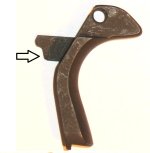- Joined
- Apr 4, 2006
- Messages
- 19,294
- Reaction score
- 30,196
These particular ceramic stones sold by Brownells are very high quality. They have precision ground sides and very sharp 90 degree corners. They are perfect for use with jigs, are the proper length, and give a very clean, highly polished mirror finish on engagement surfaces. The black stone is medium fine and the white is extra fine. A great investment, and if properly cared for, will last a long, long time.
BROWNELLS 6" X 1/2" X 1/2" CERAMIC STONES | Brownells
The stones sold by Brownell's are good stones - no argument there. I have had them for many years and do use them. The Arkansas Stones I was making reference to are smaller (3/16 square and 1/4" square), finer and get into places the Brownell's Stones can not. The small Arkansas are super useful when doing fine and critical work. They are agile enough to use on S&W Cylinder Ratchets and Notches to remove fine burrs without touching anything unintended. They fit in a 1911 trigger Track perfectly and you won't chance removing too much as they cut very very slowly and smoothly.
I also use Arkansas "mini-stones (or files as Dan's refer to them) to do the final dressing on Bubba'd screw heads (just before polishing on a wheel) when I restore them. It allows complete control of exactly what you want to stone and leaves other parts clean. These little A. S's are one of my most used GS-ing tools. Since I am not a professional and not doing this for a profit, I don't care how long it takes - I just want the best job I am capable of even if it takes longer.
PS: Since they are so fine it is critical to clean them out with Honing Oil after using them. This in turn keeps them clean and cutting properly. This also applies to all Stones IMO.

